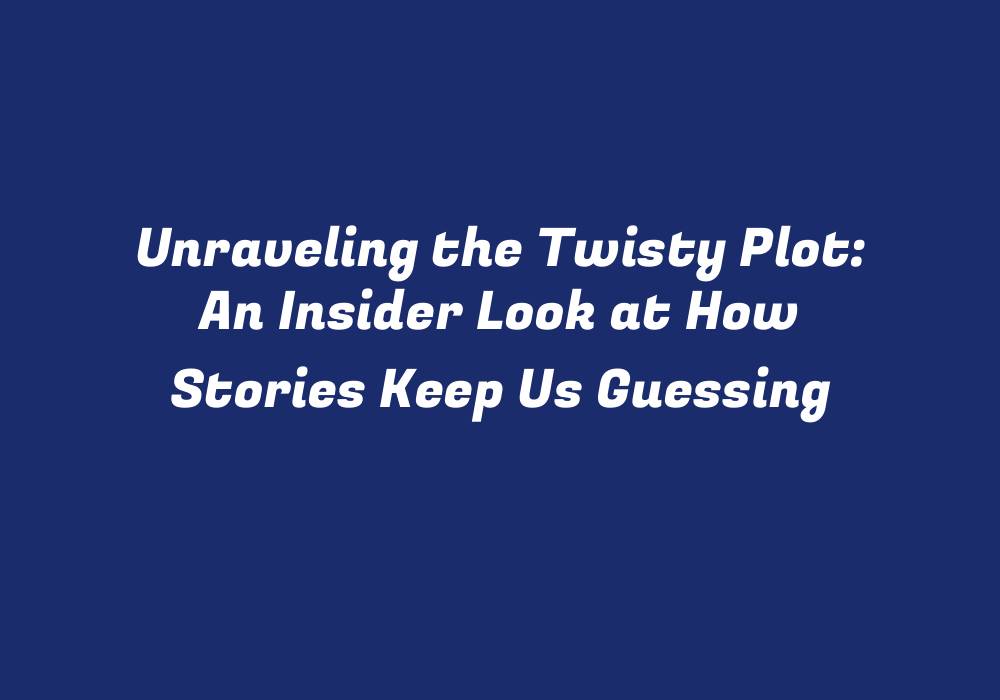Unraveling the Twisty Plot: An Insider Look at How Stories Keep Us Guessing
Every time we pick up a book, switch on our favorite TV series, or sit down to watch a movie, our minds are constantly searching for that one thing that sets it apart from the rest. We want to experience something unique and unexpected, craving stories that keep us guessing. This article will dive into the world of storytelling and explore the various elements and techniques used by writers and creators in crafting engaging plots. Let’s unravel the mystery behind our insatiable curiosity for well-crafted narratives.
The Elements of a Compelling Plot
Characters: Characters are the heart and soul of any story. They bring life to the narrative, making us care about their journey as we root for them or despise them. Great characters possess depth, complexity, and an inner conflict that makes them relatable, ensuring our investment in their story. To create a twisty plot, writers must give equal attention to character development, as it plays a crucial role in shaping the narrative’s direction.
Plot Structure: A well-designed plot structure is the backbone of any story, providing an organized and coherent flow from beginning to end. From setting up the protagonist’s goals to delivering a climax where our expectations are challenged, effective storytelling requires a strong understanding of the structure. By mastering the art of plotting, writers can keep readers intrigued and eager for what comes next.
Conflict: Conflicts drive a narrative forward, as they introduce challenges that test our characters’ resolve and force them to make difficult decisions. When conflicts are unexpected or carry deep-rooted consequences, it leaves readers guessing about how the story will unfold. By incorporating various types of conflict—internal, external, or interpersonal—writers can create complex plots that keep us hooked.
Techniques to Keep Readers Guessing
Misdirection: A common technique used in storytelling is misdirection. This involves leading the audience or reader down one path while quietly laying the groundwork for an entirely different plot twist. By cleverly manipulating their perceptions, writers can keep readers guessing until the very end when the true nature of a situation is revealed.
Red Herrings: Red herrings are false clues or misleading information that seem important to the story but ultimately do not serve the plot’s purpose. They help create suspense and confusion, leaving readers unsure about what is essential to the overall narrative. Writers can use red herrings strategically throughout a story to keep readers guessing about their significance and to generate intrigue in unexpected directions.
Subtle Clues: Sometimes, subtle clues or hints are left for attentive readers to uncover. These small details can be woven into the narrative, adding depth and complexity to a story’s worldbuilding while also hinting at future plot twists or character developments. By incorporating these nuanced elements, writers can keep readers actively engaged in trying to decipher the overall story’s direction.
Mastering the Art of Surprise Endings
Unexpected Resolutions: A great twisty plot usually culminates with a surprising ending that defies our expectations. By thinking outside the box, writers can craft stories that leave readers astonished and yearning for more. Whether it’s through an unconventional climax or a shocking reveal about a character’s true identity, well-crafted surprise endings are essential to creating engaging narratives.
Changing Perspectives: Another effective technique is changing the perspective of the storytelling. By providing different points of view or shifting between first and third person narration, writers can keep readers guessing about what might happen next and reveal hidden layers to a character’s motivations.
Embracing Uncertainty: In some instances, the most intriguing stories are those that don’t neatly tie everything up. By embracing uncertainty and leaving certain elements unresolved or open to interpretation, writers can create engaging plots that resonate with readers long after they finish a story.
Conclusion
As we continue to consume stories through various mediums, the demand for engaging, twisty narratives remains high. To create such captivating plots, writers and creators must master their craft by exploring different elements and techniques that keep readers guessing until the very end. By combining strong characters, well-structured plotting, and strategic storytelling methods, we can delve deeper into the world of storytelling and appreciate the power it has to captivate our imaginations.
Exploring Further: Some Twisty Plots Worth Discussing
- The Sixth Sense (M. Night Shyamalan)
- Shutter Island (Dennis Lehane)
- Gone Girl (Gillian Flynn)
- The Usual Suspects (Christopher McQuarrie)
- The Prestige (Christopher Nolan, Jonathan Nolan, and Christopher Priest)
These are just a few examples of twisty plots that have captivated audiences worldwide. As we explore more stories with unexpected plot twists and surprising endings, the art of storytelling continues to evolve and challenge our expectations.
